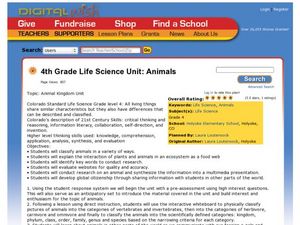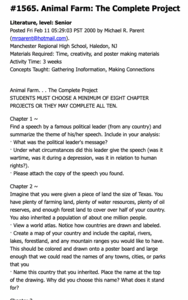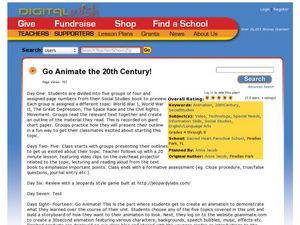SeaWorld
Animal Migrations
Here is a fabulous set of activities for your young scientists. Each lesson contains map, hands-on, and game activities that will help the class understand why and how animals migrate from one place to another. First they'll examine the...
Curated OER
Dogfighting Lesson Two - Bite Prevention and Community
Students discover how to prevent dog bites by completing worksheets and watching a video. In this animal safety lesson, students view a video called Dogs, Cats and Big Kids, taking notes throughout. Students take a quiz...
Curated OER
Animal Masks
Learners create wonderfully animate animal masks out of balloons. They use the papier-mache technique to create three dimensional animal masks taking care to consider color, shape, texture, and the animals' features.
Curated OER
Farm Animal Coverings
Students inquire about the different coverings that farm animals have. They identify feathers, hair and fur. They categorize animals into either farm animals or zoo animals. They gather pictures of various domestic and wild animals from...
Curated OER
Plant and Animal Cells
Students investigate parts of a cell. In this plant cell lesson, students determine the difference between plant and animal cells. Students discover that coral is an animal based on cell characteristics. Students create puppets to...
Curated OER
English Lesson Plans for Grade 12
HIgh schoolers respond to a persuasive article on using animal research. In this english lesson, writers listen to a conversation, and discuss the point of arguments. They write a critique on a certain film and share it with their...
Curated OER
Animal Habitat Dioramas
What a better way to have learners show what they know than with a diorama? Kids research an animal, its habitat, ecosystem, and environment in order to create a three-dimensional diorama. Have older children write a short paper on their...
Curated OER
4th Grade Life Science Unit: Animals
Fourth graders classify animals. In this animal kingdom lesson, 4th graders research animal habitats and behaviors. Students connect to a zoologist via SKYPE and learn about animal classification. Students blog about preserving animal...
Curated OER
Lesson Plans for Winter
Students participate in several winter-themed lessons. In this seasonal lesson, students study penguins and polar bears by animal masks for dramatic play. Additionally, students construct winter calendars and celebrate the season of...
Curated OER
Animal Camouflage
Students investigate how animals adapt to their environment. In this animal science lesson, students participate in an experiment using patterned paper and plain paper to simulate how animals blend into their surroundings. Students...
Curated OER
Animal Farm: The Complete Project
Learners choose chapters from "Animal Farm" to complete a project on. They make connections between the characters and gather any outside information needed. They present their information to the class.
Curated OER
Go Animate the 20th Century!
Students create animations to match their social studies. in this 20th century lesson, students work in groups to read and present to their classmates World War I, World War II, The Great Depression, The Space Race, or the Civil Rights...
Curated OER
Marine Animal Life Cycles
Students study the life cycle of a crab and the larval stages of marine animals. In this marine animals lesson, students watch a puppet introduction to a crab's life cycle. Students learn about crab moulting and their life cycle...
Curated OER
Animal Classification
Students classify animals. In this animal classification lesson, students identify characteristics from each of the 5 categories of vertebrates. Students group animals by categories.
National Wildlife Federation
What's Your Habitat?
How are third graders like rabbits? They both live in habitats and require food, water, and shelter to survive! An educational science lesson encourages your learners to think about their own habitats and survival needs, before comparing...
Sea World
Endangered Species
Study different endangered species with several activities that incorporate math, science, language arts, and research strategies. A great addition to your lesson plan on conservation or Earth Day.
Curated OER
A Planet Full of Animals
Students study animals and practice classifying them through observation activities. In this animal classification lesson plan, students complete a KWL chart about animals. Students then sort pictures of animals into chart categories...
Curated OER
Animals Galore
A well-designed lesson which covers the characteristics of the animals found in the six animal groups is here for your young biologists. In it, learners divide up into six groups; the amphibians, reptiles, mammals, birds, fish, and...
Curated OER
Integrating Anime and Manga into an Art of Motion Picture Course
Students examine the art of Anime and note its characteristics. Using scenes, they identify the plots, characters and themes trying to be portrayed. In groups, they compare and contrast the animation in America to that of Anime and...
Curated OER
Animal Brochures
Fourth graders work in pairs to research an animal. They fill in an animal data form in order to become experts about the animal they choose. They use the listed criteria to design a six sided brochure that includes graphics of the...
Curated OER
Fish Fashion 101
Young scholars explore fish anatomy. In this fish anatomy and adaptation lesson, students define and identify the location of fish body parts. Young scholars add these parts of a fish's anatomy to a life-sized fish costume worn by a...
Curated OER
Animals
Students demonstrate and understanding of animal coverings and types of movement through drawings, making of booklets and categorization activities.
Curated OER
Lesson 2: the Cell Cycle
Students explain how cells reproduce. In this biology lesson, students explain the different stages of the cell cycle. They calculate the number of new cells produced.
Intel
Lights, Camera, Reaction!
Excite classes with a STEM project-based learning lesson covering chemical reactions. Groups study the different types through simulations and hands-on activities. They pick one type (synthesis, decomposition, single displacement, double...

























